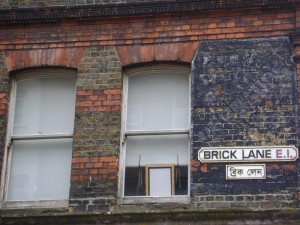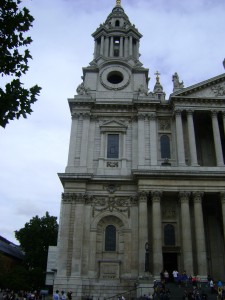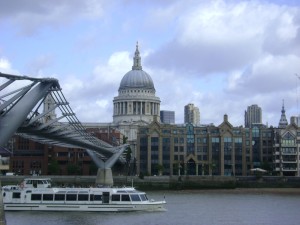
“You’re sacred space is where you can find yourself over and over again.” (Joseph Campell)
The concept of space, so immense, so undefined. As intriguing as one may be with the notion of sacred spaces, either physical or internal, it is difficult to grasp the full idea of what it means to feel a part of a specific space, to immerse oneself in it.
As we entered the Gudwara, internally, I had just opened the door to a room of confusion, although physically I was right where I was supposed to be. The ability to learn extensively in moments of discomfort is something I attempt to take advantage of, but for some reason I was unable to keep an open mind. Throughout our tour, I felt a sense of indifference, not just because I am not a religious individual in any way, but also because I like to keep myself at a distance from spaces that with hold religious power over a community. Surprisingly, my experience at St.Paul’s was not in any way similar to the Gudwara’s. At St.Pauls’ I felt as if I was entering a museum, a sacred place of historical exhibition instead of worship. In comparison to Westminster Abbey, St.Pauls’ was less scary (maybe because there aren’t 3000 bodies buried there). I think tourism has completely changed the dynamic of these sacred spaces, converting them into exhibits for the general public.
So what differs a museum from a place of worship? In London, I think museums as well as churches are both worshipped in their own ways. We have visited multiple museums and various churches in our time in London, where I have realized that it takes more than just a space to create a place of worship, it takes the masses, the worshippers, to raise a space to a state of “holy-ness.” When we have class at the Victoria Gardens at Regents Park, the patch of grass surrounding us, the space chosen for our discussions is our sacred space for that moment; when we enter it, we become a part of it, not just literally but also metaphorically.
When we entered the Gudwara, most of us were encountered with unknown territory, strange feelings awakened. Although, this space was not at all a tourist attraction, our presence in that place made it feel like another museum exhibit, like something to study, observe and take notes on for future reference… not a place of sacred worshiping. Isn’t it interesting how this concept of space dominates our everyday lives, yet it is so undefined.
Indefinitely, whatever you’re sacred space is, make it yours. Personalize it, love it, breath it, worship it… define it for yourself, in the hopes that you’ll continue to find yourself in that place over and over again.
Tags: Flow

So this is an overdue post comparing our experiences at the National Gallery and the Tate Modern.
When we were climbing the steps of the National Gallery we were anticipating the beautiful pieces that would be displayed by world renowned artists. We were excited to see the works of Van Gogh, Da Vinci, Van Dyck as well as artists who are unfamiliar to us. While standing in front of Da Vinci’s Madonna and Child, observing his rather passionate and intricate work we felt a disconnect between our previous assumptions of how the work was suppose to affect us versus our actual interpretations. Based on our shared knowledge of these artistic “masterpieces” we hoped to feel the sense of awe. Although we were privileged to be viewing these works, we left feeling rather “eghhh” (for lack of a better term).
Our experience at the Tate Modern JUXTAPOSED our feelings of incomplete satisfaction at the National Gallery. We were immediately intrigued by the modern and uncommon artistic works. These revolutionized pieces made us question the true meaning of art. IN our interpretation of the works found at Tate, modern art in Britain completely attempts to move away from traditional, classical art found at the National Gallery. Although we do appreciate classical art, modern art speaks to us in a different form, and it relates to the ways in which we seek to see the rest of our society— in distinctive ways. The Tate Modern seems to be “pushing the envelope” when it comes to artistic expressions and we enjoy that sort of rebellious attitude.
Overall, art is an interpretation of the individual and it can exist in various forms. It is always inspired and interpreted.
Tags: Anthony · Flow · Jeyla
On Wednesday September 2nd, 2009 the Norwich Humanities group visited the East End, in particular, Brick Lane, and the surrounding area. Brick Lane’s history over the past 15 years had changed drastically. It has gone from a neighborhood of violence, drugs, and trash, to a respectable neighborhood. This area has seen drastic progress in this fifteen year period, but progress at the expense of who?
 People always view progress as a positive thing, because, it means improvement for a community that means it. What I have learned being in London, is that progress has the potential to be something great, but at the expense of who? Professor Qualls has made me realize these past few days, is that the concept of progress is something beneficial, to a specific group, but at the expense of who? In order for true progress to be made a specific group must pay. Looking at the east end, it is obvious that the area is becoming economically improved, but at the expense of the middle and working classes in the area. The area is beginning to see major improvements, in both the markets and financial district, but the lower classes are taking a beating, because soon they will not be able to afford the area in which they live, and will be forced to move out. In essence this is progress in its truest form. However, it felt surreal to be in an area in which we have read so much about, and viewing the drastic changes in the area, gave me a sense of joy, but this emotion was balanced with a sense of sadness because of the effects this had on the community.
People always view progress as a positive thing, because, it means improvement for a community that means it. What I have learned being in London, is that progress has the potential to be something great, but at the expense of who? Professor Qualls has made me realize these past few days, is that the concept of progress is something beneficial, to a specific group, but at the expense of who? In order for true progress to be made a specific group must pay. Looking at the east end, it is obvious that the area is becoming economically improved, but at the expense of the middle and working classes in the area. The area is beginning to see major improvements, in both the markets and financial district, but the lower classes are taking a beating, because soon they will not be able to afford the area in which they live, and will be forced to move out. In essence this is progress in its truest form. However, it felt surreal to be in an area in which we have read so much about, and viewing the drastic changes in the area, gave me a sense of joy, but this emotion was balanced with a sense of sadness because of the effects this had on the community.
 We later travelled to St. Pauls’ lead by our fabulous tour guide John. John was our tour guide for the West Minster Abbey, and because he did such an amazing job, professor Qualls decided John was more than capable to lead us in this national land mark of London. Once we all had arrived John began speaking about the birth of the St. Pauls’ Cathedral and the route and the history of its name. One thing Jon said before entering that I didn’t agree with was when he said, “be mindful that this place is still a church so please be mindful.” Once I entered St. Paul’s cathedral, I immediately noticed the outrageous fee to enter this “church.” I could not help but see this ever apparent contradiction, in that museum cost money, and churches are supposed to be free. Not only that but the electronic tour guides, and the amount of people who just seemed interested in looking at its architecture rather than praising god could have not convinced me more, that this Cathedral had lost its “holiness” a long time ago, at least in my opinion. My perceptions of St. Paul as a tourist attraction, however, were nothing but positive. The architecture was beautiful, and its history was astounding. As I climbed the steps of St. Pauls’ I could not help but think that in the immediate future I would be on the top of the city.
We later travelled to St. Pauls’ lead by our fabulous tour guide John. John was our tour guide for the West Minster Abbey, and because he did such an amazing job, professor Qualls decided John was more than capable to lead us in this national land mark of London. Once we all had arrived John began speaking about the birth of the St. Pauls’ Cathedral and the route and the history of its name. One thing Jon said before entering that I didn’t agree with was when he said, “be mindful that this place is still a church so please be mindful.” Once I entered St. Paul’s cathedral, I immediately noticed the outrageous fee to enter this “church.” I could not help but see this ever apparent contradiction, in that museum cost money, and churches are supposed to be free. Not only that but the electronic tour guides, and the amount of people who just seemed interested in looking at its architecture rather than praising god could have not convinced me more, that this Cathedral had lost its “holiness” a long time ago, at least in my opinion. My perceptions of St. Paul as a tourist attraction, however, were nothing but positive. The architecture was beautiful, and its history was astounding. As I climbed the steps of St. Pauls’ I could not help but think that in the immediate future I would be on the top of the city.
 Once I arrived the scenery was amazingly beautiful, I had never seen such an astounding sight. I was able to view London from an entirely different vantage point, and in doing so, I realized the true beauty of this chaotic city. I realized that, London, was the only city I have ever been to that had such an interesting personality, from the people, to its appearance, its multifaceted diversity was something that out of a book. It was something I will not soon forget!!!
Once I arrived the scenery was amazingly beautiful, I had never seen such an astounding sight. I was able to view London from an entirely different vantage point, and in doing so, I realized the true beauty of this chaotic city. I realized that, London, was the only city I have ever been to that had such an interesting personality, from the people, to its appearance, its multifaceted diversity was something that out of a book. It was something I will not soon forget!!!

Tags: Anthony



 People always view progress as a positive thing, because, it means improvement for a community that means it. What I have learned being in London, is that progress has the potential to be something great, but at the expense of who? Professor Qualls has made me realize these past few days, is that the concept of progress is something beneficial, to a specific group, but at the expense of who? In order for true progress to be made a specific group must pay. Looking at the east end, it is obvious that the area is becoming economically improved, but at the expense of the middle and working classes in the area. The area is beginning to see major improvements, in both the markets and financial district, but the lower classes are taking a beating, because soon they will not be able to afford the area in which they live, and will be forced to move out. In essence this is progress in its truest form. However, it felt surreal to be in an area in which we have read so much about, and viewing the drastic changes in the area, gave me a sense of joy, but this emotion was balanced with a sense of sadness because of the effects this had on the community.
People always view progress as a positive thing, because, it means improvement for a community that means it. What I have learned being in London, is that progress has the potential to be something great, but at the expense of who? Professor Qualls has made me realize these past few days, is that the concept of progress is something beneficial, to a specific group, but at the expense of who? In order for true progress to be made a specific group must pay. Looking at the east end, it is obvious that the area is becoming economically improved, but at the expense of the middle and working classes in the area. The area is beginning to see major improvements, in both the markets and financial district, but the lower classes are taking a beating, because soon they will not be able to afford the area in which they live, and will be forced to move out. In essence this is progress in its truest form. However, it felt surreal to be in an area in which we have read so much about, and viewing the drastic changes in the area, gave me a sense of joy, but this emotion was balanced with a sense of sadness because of the effects this had on the community. We later travelled to St. Pauls’ lead by our fabulous tour guide John. John was our tour guide for the West Minster Abbey, and because he did such an amazing job, professor Qualls decided John was more than capable to lead us in this national land mark of London. Once we all had arrived John began speaking about the birth of the St. Pauls’ Cathedral and the route and the history of its name. One thing Jon said before entering that I didn’t agree with was when he said, “be mindful that this place is still a church so please be mindful.” Once I entered St. Paul’s cathedral, I immediately noticed the outrageous fee to enter this “church.” I could not help but see this ever apparent contradiction, in that museum cost money, and churches are supposed to be free. Not only that but the electronic tour guides, and the amount of people who just seemed interested in looking at its architecture rather than praising god could have not convinced me more, that this Cathedral had lost its “holiness” a long time ago, at least in my opinion. My perceptions of St. Paul as a tourist attraction, however, were nothing but positive. The architecture was beautiful, and its history was astounding. As I climbed the steps of St. Pauls’ I could not help but think that in the immediate future I would be on the top of the city.
We later travelled to St. Pauls’ lead by our fabulous tour guide John. John was our tour guide for the West Minster Abbey, and because he did such an amazing job, professor Qualls decided John was more than capable to lead us in this national land mark of London. Once we all had arrived John began speaking about the birth of the St. Pauls’ Cathedral and the route and the history of its name. One thing Jon said before entering that I didn’t agree with was when he said, “be mindful that this place is still a church so please be mindful.” Once I entered St. Paul’s cathedral, I immediately noticed the outrageous fee to enter this “church.” I could not help but see this ever apparent contradiction, in that museum cost money, and churches are supposed to be free. Not only that but the electronic tour guides, and the amount of people who just seemed interested in looking at its architecture rather than praising god could have not convinced me more, that this Cathedral had lost its “holiness” a long time ago, at least in my opinion. My perceptions of St. Paul as a tourist attraction, however, were nothing but positive. The architecture was beautiful, and its history was astounding. As I climbed the steps of St. Pauls’ I could not help but think that in the immediate future I would be on the top of the city. Once I arrived the scenery was amazingly beautiful, I had never seen such an astounding sight. I was able to view London from an entirely different vantage point, and in doing so, I realized the true beauty of this chaotic city. I realized that, London, was the only city I have ever been to that had such an interesting personality, from the people, to its appearance, its multifaceted diversity was something that out of a book. It was something I will not soon forget!!!
Once I arrived the scenery was amazingly beautiful, I had never seen such an astounding sight. I was able to view London from an entirely different vantage point, and in doing so, I realized the true beauty of this chaotic city. I realized that, London, was the only city I have ever been to that had such an interesting personality, from the people, to its appearance, its multifaceted diversity was something that out of a book. It was something I will not soon forget!!!